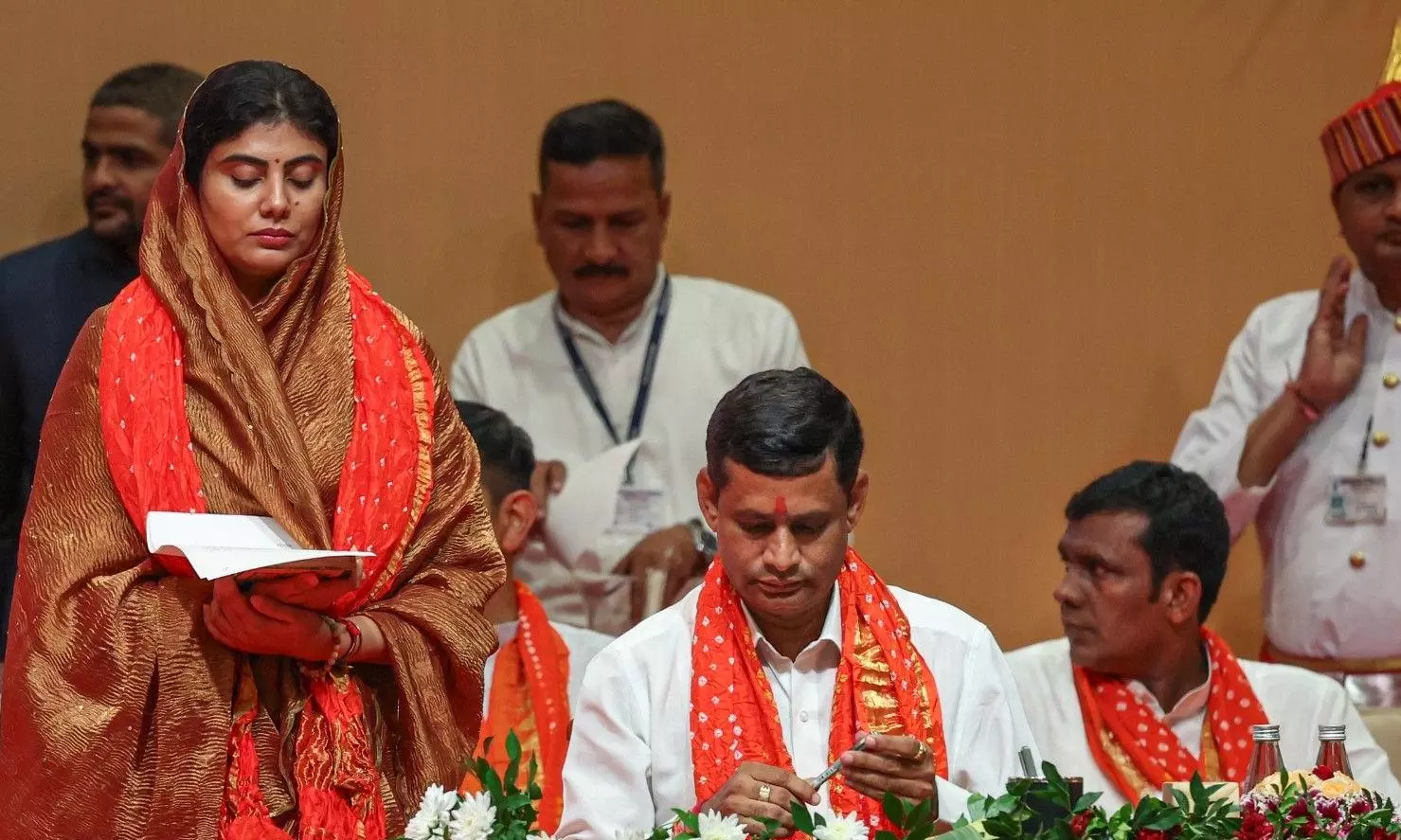
Gujarat cabinet reset reveals caste calculus, regional balancing act
With eye on 2027 polls, BJP expands Saurashtra presence, elevates OBC, tribal, Patidar, women leaders while rewarding loyalists and consolidating party factions

The Bhupendra Patel-led Gujarat government on Friday (October 17) swore in 26 MLAs as ministers in a cabinet reshuffle. The new team includes significant representation from the Saurashtra-Kutch region and a mix of caste groups, aligning with the party’s strategy for the upcoming civic election and 2027 assembly polls.
“After a celebratory dinner to be held at the Chief Minister's residence, the new ministers have been asked to head straight to the respective constituencies by Diwali to boost activities on the ground. However, the leaders can choose to shift their official residences and offices before Diwali or after the celebration of Labh Pancham on October 26, which marks the Gujarati New Year," a senior BJP leader from Gandhinagar told The Federal.
Regional and caste representation
The cabinet reflects BJP's effort to maintain a regional balance.
Saurashtra-Kutch: 9 MLAs
Central Gujarat: 6 MLAs
North Gujarat: 4 MLAs
South Gujarat: 3 MLAs (from the previous cabinet)
Caste representation includes:
OBCs: Kuvarji Bavalia, Parsottam Solanki, Arjun Modhwadia, Ishwarsinh Patel, Pravin Mali, Trikam Changa, Swarup Thakor
Patidars: Bhupendra Patel, Jitu Vaghani, Rushikesh Patel, Kanti Amrutiya, Kaushik Vekariya, Kamlesh Patel, Praful Panseria
Tribal MLAs: Naresh Patel, Jairam Gamit, Ramesh Katara, PC Baranda
Dalits: Manisha Vakeel, Darshana Vaghela, Pradyuman Vaja
For the first time, the BJP inducted three women:
Rivaba Jadeja (Jamnagar North), from the Darbar OBC community and wife of cricketer Ravindra Jadeja
Darshana Vaghela, a Dalit MLA from Asarwa and former deputy mayor of Ahmedabad
Manisha Vakeel, a three-time Dalit MLA from Vadodara City, former MoS for Women and Child Development
Strategic moves
Political analysts suggest the reshuffle is designed to strengthen the BJP’s hold in Saurashtra-Kutch, a region previously dominated by Congress; counter AAP’s emergence after Gopal Italiya’s win in Visavadar; and manage internal caste dynamics, especially among OBCs and tribals.
Harsh Sanghavi, a close aide of Modi and Amit Shah, he is known for his hardline stance on law and order and active involvement in tribal areas.
The inclusion of three tribal MLAs and the heavy presence from Saurashtra align with the party’s aim to sustain momentum in underdeveloped regions where it gained ground post-2017.
Also read | How satellite survey glitch has left 80,000 Gujarat groundnut farmers in the lurch
“Saurashtra and the tribal region of South Gujarat are two areas where the BJP has gained foothold post 2017. The regions were Congress strongholds until the BJP kept sweeping local polls, civic polls and even APMC (Agricultural Produce Market Committee) polls since 2019. Finally, it won the 2022 state polls in those seats," political analyst Ghansham Shah told The Federal.
Importance of Saurashtra
"However, it is important for the party to sustain the momentum in the regions that are relatively less developed. It is no surprise that the BJP gave prominence to the Saurashtra Kutch region and chose three tribal MLAs to join the new cabinet," Shah noted.
"Despite a heavy infiltration of its sister organization RSS in Saurashtra-Kutch and the tribal belt of South Gujarat, the BJP’s typical anti-minority politics doesn’t seem to work in the regions. The primary reason is the social division of the subcaste of OBCs in Saurashtra -Kutch and Christian majority in most seats in the tribal belt. The party had to come up with ways to woo the caste leaders of these two areas,” he further said.
Regional representation
But, it appears caste dynamics were not the only concern.
“More than caste dynamics, the BJP has seen to it that all the regions of Gujarat get balanced representation. This will help the party to better manage the regions ahead of the upcoming local and civic polls and also the state polls slated for 2027,” Prof Sirish Kashikar, a political analyst based in Ahmedabad, told The Federal.
Also read | Why top leaders across parties are making a beeline for Saurashtra
“In North Gujarat, the BJP has chosen Vav MLA Swarup Thakor, from the Thakor community, instead of veteran leader Shankar Chaudhary. It seems the move is aimed to address two issues at once — the anger of local people over the carving out of the new Vav-Tharad district from Banaskantha, and to give representation to the numerically significant Thakor community," Kashikar added.
"It also needs to be noted that the BJP did not trust Congress turncoat Alpesh Thakor and chose its own Swarup Thakor, who is not only a close aide of Shankar Chaudhary but also been a deputy president of the Thakor Sena that is headed by Alpesh now,” he further said.
Sanghavi’s rise
Harsh Sanghavi, 40, began his political career at 27 and has risen swiftly. A close aide of Prime Minister Narendra Modi and Union Home Amit Shah, he is known for his hardline stance on law and order and active involvement in tribal areas.
Also read | Why Gujarat Home Minister Harsh Sanghavi got the label Next Amit Shah
His appointment as Deputy CM is seen as a reward for his loyalty and administrative style.
“Like Shah, Sanghavi has been taken a very vocal anti minority stand since he became the state Home Minister. His move to give the police unconstitutional freedom in parading accused persons, or demolishing the homes of people on mere suspicion of being accused in a crime, has earned him popularity and a secure spot within the BJP. His elevation within the government might be a result of that,” said Kashikar.

